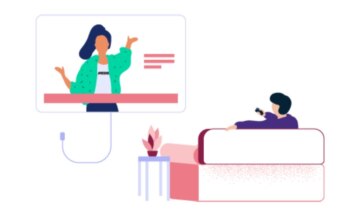How to Guide Clients with Thought Leadership from Afar

As with most time of upheaval and uncertainty, you’re probably already communicating more with key audience. Rules and regulations change daily (if not hourly), and it can be difficult for your clients to keep up while running businesses. Rapidly changing developments have a profound impact on your clients, who need guidance on how to respond.
Webinars let you be helpful at a time when the safety of social distance is tantamount.
This post originally appeared on jdsupra.com. Shared with the author’s permission.
You can transmit valuable thought leadership to your audience in a way that keeps the interaction human and responsive. They’re easy to produce and easy to access. What’s more, they let participants – most of whom are probably working from home too – actively participate in the session, see your face, and gauge your confidence and authority.
Three considerations as you step up your thought leadership:
1. Find more opportunities to help
Consider organizing a weekly “Pandemic update” for clients in a particular region or industry. It doesn’t have to be long, but it should explain recent developments and advise on potential responses. You could even target individual clients with webinars and content tailored specifically to their situations.
Setup personalized experiences to house the archive of webinars and other materials your clients will need, like this one we created to help our customers cross the physical/digital divide.
Use your platform to host an open Q&A session where you can get a read on business concerns, answer the questions suited for you, and again: be helpful. Hosting a weekly internal meeting with your client whose employees are now working from home is a great way to get to know the concerns of your clients while offering real-time support and solutions.
Sometimes just giving clients a forum to ask questions and share ideas is enough to help them understand their options for dealing with uncertainties. Schedule a webinar for Friday afternoons, when the workweek is nearly over, a kind of social distancing reception where the guided conversation is centered around working together to get through this unprecedented situation.
2. Use short-term innovation to launch long-term digital solutions
Rapidly shifting to online-only events can seem drastic and sudden, but supplementing the webinar content you produce doesn’t have to be temporary.
We’re always encouraging customers to give digital a bigger role in their marketing and business development strategies, both to complement physical, face-to-face events and also to give their audience more opportunities to see them “in action.”
That’s easier to do when continuing programs you develop in response to the current environment.
3. Mind the data (and the lessons)
In your rush to put together new programs for your audience, it’s important to remember that a webinar produces the same amount of data and lessons whether it has been planned for six months or six hours.
Either way, you refine your lists of topics that matter to your audience, of clients that follow your thought leadership, and of prospects with whom you can follow up. Make sure you’re capturing attendance and engagement data, and passing it on to the appropriate people and systems for analysis and follow up.
